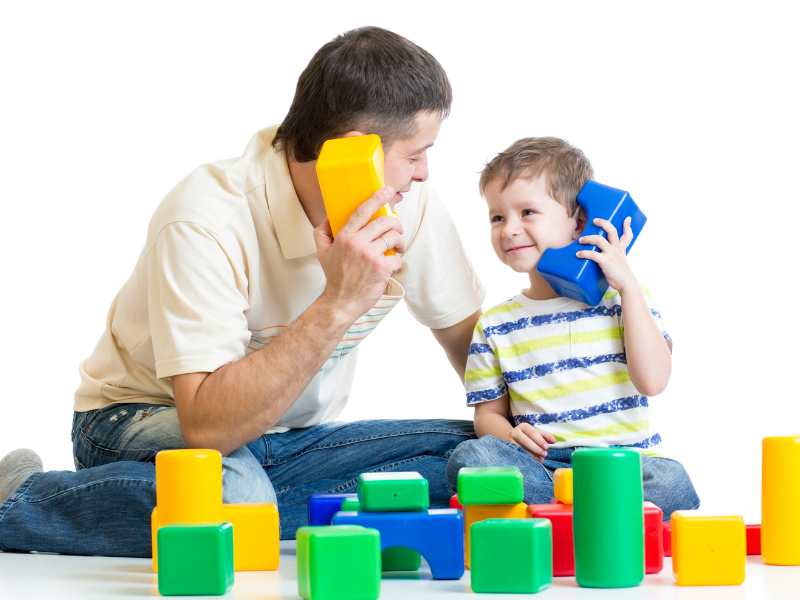This article walks you through the ways to discipline your kids without yelling you can introduce into your daily routine.
Disciplining children is a fundamental aspect of parenting, but it often comes with its challenges.
Many parents find themselves resorting to yelling out of frustration or desperation, only to realize that it may not be the most effective or constructive approach.
Yelling can create an atmosphere of fear and resentment, ultimately hindering a child’s emotional growth and the parent-child relationship.
Let us discuss the various strategies and methods that can help you discipline your kids effectively, without raising your voice.
These techniques are designed to foster respect, understanding, and cooperation, creating a more harmonious and positive family environment.
In case, you’re dealing with a toddler’s tantrums or a teenager’s defiance, these approaches will equip you with the tools to handle disciplinary situations with patience and empathy.
23 EFFECTIVE WAYS TO DISCIPLINE YOUR KIDS WITHOUT YELLING
1. Set Clear Expectations
 Clearly define and communicate your household rules and what behaviors are acceptable.
Clearly define and communicate your household rules and what behaviors are acceptable.
Use simple language appropriate for your child’s age and repeat these rules regularly. This clarity helps children understand boundaries and reduces confusion.
2. Positive Reinforcement
 Encourage good behavior by acknowledging and rewarding it.
Encourage good behavior by acknowledging and rewarding it.
Praise your child for specific actions (“Great job on cleaning your room!”) and offer rewards like extra playtime or a special treat.
Positive reinforcement helps build self-esteem and encourages the repetition of desired behavior’s.
3. 
Consistency is key in discipline. Ensure that consequences for misbehavior are predictable and applied every time a rule is broken.
This consistency helps children understand the link between their actions and outcomes and this is one of the perfect ways to discipline your kids without yelling.
4. Time-Outs
 Time-outs give children a break to cool down and reflect on their behavior.
Time-outs give children a break to cool down and reflect on their behavior.
Designate a quiet, safe spot for time-outs. The time-out duration should be appropriate for your child’s age (e.g., one minute per year of age).
5. Natural Consequences
 Allow your child to experience the natural outcomes of their actions when it’s safe. For example, if they refuse to wear a coat, they might feel cold.
Allow your child to experience the natural outcomes of their actions when it’s safe. For example, if they refuse to wear a coat, they might feel cold.
Natural consequences help children learn from their experiences, which is one of the best ways to discipline your kids without yelling.
6. Logical Consequences
 Ensure that consequences are directly related to the misbehavior. For instance, if your child draws on the walls, they should help clean it up.
Ensure that consequences are directly related to the misbehavior. For instance, if your child draws on the walls, they should help clean it up.
Logical consequences make the discipline more meaningful and relevant.
7. Model Appropriate Behavior
 Children learn by observing adults. Demonstrate the behavior you want to see, such as using polite language, showing respect, and handling conflicts calmly.
Children learn by observing adults. Demonstrate the behavior you want to see, such as using polite language, showing respect, and handling conflicts calmly.
Modelling teaches children how to act in various situations.
8. Stay Calm
 Keeping your composure during challenging moments sets a powerful example for your child. It shows them how to manage emotions and handle stress.
Keeping your composure during challenging moments sets a powerful example for your child. It shows them how to manage emotions and handle stress.
Take deep breaths or step away for a moment if needed to stay calm.
9. Use “I” Statements
 Communicate your feelings without blaming your child. For example, say, “I feel upset when you don’t listen,” instead of “You never listen.” This approach reduces defensiveness and fosters understanding.
Communicate your feelings without blaming your child. For example, say, “I feel upset when you don’t listen,” instead of “You never listen.” This approach reduces defensiveness and fosters understanding.
10. Give Choices
 Providing choices empowers your child and encourages responsibility.
Providing choices empowers your child and encourages responsibility.
Offer limited options (“Do you want to do homework before or after dinner?”) to guide their behavior while giving them a sense of control.
11. Redirect Behavior
 When you notice misbehavior, divert your child’s attention to a more appropriate activity. For example, if they’re fighting over a toy, suggest playing a different game together.
When you notice misbehavior, divert your child’s attention to a more appropriate activity. For example, if they’re fighting over a toy, suggest playing a different game together.
12. Problem-Solving
 Engage your child in finding solutions to their behavior issues.
Engage your child in finding solutions to their behavior issues.
Discuss what happened, and why it’s a problem, and brainstorm ways to prevent it in the future. This teaches critical thinking and accountability.
13. Set a Routine
 Establishing a consistent daily schedule provides structure and predictability.
Establishing a consistent daily schedule provides structure and predictability.
Routines help children know what to expect, reducing anxiety and resistance to transitions.
14. Teach Empathy
 Help your child understand how their actions affect others.
Help your child understand how their actions affect others.
Discuss feelings and perspectives (“How would you feel if someone took your toy?”) to cultivate empathy and kindness.
15. Use Humor
 Lightening the mood with humors can defuse tension and make discipline more pleasant. Use jokes or playful gestures to redirect behavior without causing stress.
Lightening the mood with humors can defuse tension and make discipline more pleasant. Use jokes or playful gestures to redirect behavior without causing stress.
16. Be Proactive
 Anticipate and address potential behavior issues before they escalate. For example, if your child struggles with sharing, practice sharing games and discuss why sharing is important.
Anticipate and address potential behavior issues before they escalate. For example, if your child struggles with sharing, practice sharing games and discuss why sharing is important.
17. Teach Conflict Resolution
 Guide your child in resolving disputes peacefully.
Guide your child in resolving disputes peacefully.
Encourage them to express their feelings, listen to others, and find mutually acceptable solutions. This skill is valuable for lifelong relationships.
18. Practice Active Listening
 Show your child that you value their thoughts and feelings by listening attentively. Repeat back what they say to confirm understanding and validate their emotions.
Show your child that you value their thoughts and feelings by listening attentively. Repeat back what they say to confirm understanding and validate their emotions.
19. Set Limits
 Clearly define and enforce limits. Explain the reasons behind the rules and be firm but fair in their application.
Clearly define and enforce limits. Explain the reasons behind the rules and be firm but fair in their application.
Consistent limits provide a sense of security and help children understand boundaries.
20. Use Visual Aids

Visual tools like charts, schedules, and reminders can reinforce rules and routines.
For younger children, use pictures and stickers to make the process engaging and understandable.
21. Teach Self-Regulation
 Encourage your child to recognize and manage their emotions.
Encourage your child to recognize and manage their emotions.
Teach techniques like deep breathing, counting to ten, or taking a break when they feel overwhelmed.
22. Offer Physical Affection
 Physical touch, such as hugs and pats on the back, can reassure and comfort your child.
Physical touch, such as hugs and pats on the back, can reassure and comfort your child.
Positive physical interactions strengthen your bond and make discipline more effective.
23. Use Storytelling
 Share stories that illustrate the consequences of different behaviors. Stories can be from books, your experiences, or made-up scenarios.
Share stories that illustrate the consequences of different behaviors. Stories can be from books, your experiences, or made-up scenarios.
They help children understand complex concepts in a relatable way.
STRATEGIES FOR STAYING CALM WHEN KIDS MISBEHAVE
1. Take Deep Breaths
 Practice deep breathing exercises to help you stay calm. Inhale slowly through your nose, hold for a few seconds and exhale slowly through your mouth.
Practice deep breathing exercises to help you stay calm. Inhale slowly through your nose, hold for a few seconds and exhale slowly through your mouth.
Repeat this process until you feel more centered.
2. Count to Ten
 Give yourself a moment to pause and collect your thoughts by counting slowly to ten. This brief pause can prevent you from reacting impulsively.
Give yourself a moment to pause and collect your thoughts by counting slowly to ten. This brief pause can prevent you from reacting impulsively.
3. Step Away
 If the situation allows, take a short break from the immediate vicinity of the conflict. Stepping away for a moment can help you regain your composure and perspective.
If the situation allows, take a short break from the immediate vicinity of the conflict. Stepping away for a moment can help you regain your composure and perspective.
4. Practice Mindfulness
 Engage in mindfulness techniques, such as focusing on your breath, paying attention to your body sensations, or observing your surroundings without judgment.
Engage in mindfulness techniques, such as focusing on your breath, paying attention to your body sensations, or observing your surroundings without judgment.
Mindfulness can help you stay present and calm.
5. Remind Yourself of the Big Picture
 Remind yourself that misbehavior is a normal part of child development and an opportunity to teach your child valuable lessons.
Remind yourself that misbehavior is a normal part of child development and an opportunity to teach your child valuable lessons.
Keeping the long-term perspective in mind can help reduce immediate frustration.
6. Use Positive Self-Talk
 Replace negative thoughts with positive affirmations.
Replace negative thoughts with positive affirmations.
Remind yourself that you are capable of handling the situation calmly and that losing your temper won’t help.
7. Develop a Mantra
 Create a calming phrase or mantra that you can repeat to yourself in stressful moments, such as “Stay calm,” “I can handle this,” or “This too shall pass.”
Create a calming phrase or mantra that you can repeat to yourself in stressful moments, such as “Stay calm,” “I can handle this,” or “This too shall pass.”
8. Identify Triggers
 Be aware of specific behavior’s or situations that trigger your anger. Knowing your triggers can help you prepare and respond more calmly when they arise.
Be aware of specific behavior’s or situations that trigger your anger. Knowing your triggers can help you prepare and respond more calmly when they arise.
9. Visualize a Calm Response
 Before addressing the misbehavior, visualize yourself responding calmly and effectively. This mental rehearsal can prepare you to act more constructively.
Before addressing the misbehavior, visualize yourself responding calmly and effectively. This mental rehearsal can prepare you to act more constructively.
10. Prioritize Self-Care
 Ensure that you take care of your own physical and emotional needs.
Ensure that you take care of your own physical and emotional needs.
Adequate sleep, regular exercise, healthy eating, and relaxation techniques can enhance your overall ability to stay calm.
11. Use a Soft Voice
 Deliberately lower your voice and speak softly when addressing misbehavior.
Deliberately lower your voice and speak softly when addressing misbehavior.
A calm tone can help de-escalate the situation and influence your child to respond similarly.
It is a good strategy you can use to discipline your kids without yelling.
12. Focus on Solutions
 Shift your focus from the problem to finding a solution. Thinking about how to resolve the issue constructively can help reduce feelings of frustration.
Shift your focus from the problem to finding a solution. Thinking about how to resolve the issue constructively can help reduce feelings of frustration.
13. Practice Empathy
 Try to understand your child’s perspective and feelings. Empathizing with your child can foster compassion and reduce anger.
Try to understand your child’s perspective and feelings. Empathizing with your child can foster compassion and reduce anger.
14. Set Realistic Expectations
 Understand that children will make mistakes and misbehave as part of their growth. Setting realistic expectations for their behavior can help you stay patient.
Understand that children will make mistakes and misbehave as part of their growth. Setting realistic expectations for their behavior can help you stay patient.
15. Seek Support
 Talk to friends, family, or a support group about your parenting challenges.
Talk to friends, family, or a support group about your parenting challenges.
Sharing your experiences and hearing others’ perspectives can provide valuable insights and emotional support.
16. Reflect on Past Successes
 Recall instances when you successfully handled similar situations calmly.
Recall instances when you successfully handled similar situations calmly.
Reflecting on these successes can boost your confidence and reinforce your ability to stay composed.
17. Develop a Plan
 Have a pre-planned strategy for handling common misbehavior’s.
Have a pre-planned strategy for handling common misbehavior’s.
Knowing in advance how you will respond can reduce anxiety and help you stay calm.
18. Engage in Relaxation Techniques
 Practice relaxation techniques regularly, such as yoga, meditation, or progressive muscle relaxation, to improve your overall ability to stay calm in stressful situations.
Practice relaxation techniques regularly, such as yoga, meditation, or progressive muscle relaxation, to improve your overall ability to stay calm in stressful situations.
19. Use Humor
 When appropriate, use humors to diffuse tension. Lighthearted humor can shift the mood and make it easier to address the behavior without anger.
When appropriate, use humors to diffuse tension. Lighthearted humor can shift the mood and make it easier to address the behavior without anger.
20. Remember Your Role
 Remind yourself that you are a role model for your child. Demonstrating calmness and self-control teaches them valuable emotional regulation skills.
Remind yourself that you are a role model for your child. Demonstrating calmness and self-control teaches them valuable emotional regulation skills.
Disciplining your children without resorting to yelling is not only possible but also essential for fostering a healthy and respectful relationship.
By using a variety of effective strategies—such as setting clear expectations, using positive reinforcement, and maintaining your composure—you can guide your children’s behavior in a constructive and empathetic manner.
Staying calm and consistent, while teaching your child valuable life skills like empathy, self-regulation, and problem-solving, will create a more peaceful and supportive home environment.
Recall, that the goal of discipline is not just to correct misbehavior but to help your children grow into responsible, compassionate, and self-disciplined individuals.
Take up these techniques, and you’ll find that disciplining with patience and understanding can lead to more harmonious family dynamics and stronger parent-child bonds.
This post showed you the ways to discipline your kids without yelling you can incorporate into your lifestyle.
|
ReplyForward |